
A terrine is a glazed earthenware (terracotta, French terre cuite) cooking dish [1] with vertical sides and a tightly fitting lid, generally rectangular or oval. Modern versions are also made of enameled cast iron.

A terrine is a glazed earthenware (terracotta, French terre cuite) cooking dish [1] with vertical sides and a tightly fitting lid, generally rectangular or oval. Modern versions are also made of enameled cast iron.

French cuisine consists of the cooking traditions and practices from France.

A recipe is a set of instructions that describes how to prepare or make something, especially a dish of prepared food.
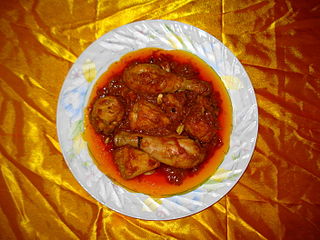
Korma or qorma is a dish originating in the Indian subcontinent, consisting of meat or vegetables braised with yogurt (dahi) or cream, water or stock, and spices to produce a thick sauce or glaze.

A casserole is a variety of a large, deep pan or bowl, typically with a glass lid, used for oven cooking a variety of dishes, as well as referring to the category of foods cooked inside it. Though the two share the same name, the pan itself is also commonly known as a "casserole dish" or "casserole pan", whereas the food inside is usually distinguished as the "casserole". The same pan is often used both for cooking and serving.
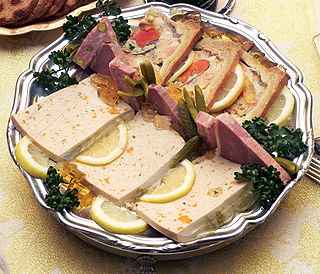
Pâté is a paste, pie or loaf consisting of a forcemeat that at least contains liver. Common additions include ground meat from pork, poultry, fish or beef, fat, vegetables, herbs, spices and either wine or brandy. Pâté can be served either hot or cold, but it is considered to develop its best flavors after a few days of chilling.

Aspic is a savory gelatin dish made with a meat stock or consommé, set in a mold to encase other ingredients. These often include pieces of meat, seafood, or eggs. Aspic is also sometimes referred to as aspic gelée or aspic jelly.
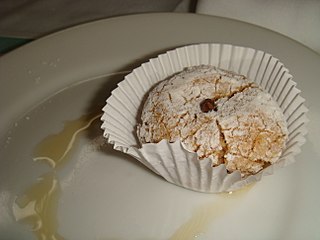
Quatre épices is a spice mix used mainly in French cuisine, but can also be found in some Middle Eastern kitchens. Its name is French for "four spices"; it is considered the French allspice. The spice mix contains ground pepper, cloves, nutmeg and dried ginger. Some variations of the mix use allspice instead of pepper or cinnamon in place of ginger.

A tureen is a serving dish for foods such as soups or stews, often shaped as a broad, deep, oval vessel with fixed handles and a low domed cover with a knob or handle. Over the centuries, tureens have appeared in many different forms, some round, rectangular, or made into fanciful shapes such as animals or wildfowl. Tureens may be ceramic—either the glazed earthenware called faience or porcelain—or silver, and customarily they stand on an undertray or platter made en suite.

In cooking and gastronomy, duck or duckling is the meat of several species of bird in the family Anatidae, found in both fresh and salt water. Duck is eaten in many cuisines around the world. It is a high-fat, high-protein meat rich in iron. Duckling nominally comes from a juvenile animal, but may be simply a menu name.

Charcuterie is a French term for a branch of cooking devoted to prepared meat products, such as bacon, ham, sausage, terrines, galantines, ballotines, pâtés, and confit, primarily from pork.

A garde manger is a cool, well-ventilated area where cold dishes are prepared and other foods are stored under refrigeration. The person in charge of this area is known as the chef garde manger or pantry chef. Larger hotels and restaurants may have garde manger staff to perform additional duties, such as creating decorative elements of buffet presentation like ice carving and edible centerpieces.

Teurgoule is a rice pudding that is a speciality of Normandy. Traditionally it was popular at village festivals in Lower Normandy, and today remains a family dish. It consists of rice cooked in milk, sweetened with sugar, and is flavoured with cinnamon and sometimes nutmeg. It is baked in an earthenware terrine for several hours. Long cooking creates a thick, brown caramelised crust over the teurgoule.

A terrine, in traditional French cuisine, is a loaf of forcemeat or aspic, similar to a pâté, that is cooked in a covered pottery mold in a bain-marie. Modern terrines do not necessarily contain meat or animal fat, but still contain meat-like textures and fat substitutes, such as mushrooms and pureed fruits or vegetables high in pectin. They may also be cooked in a wide variety of non-pottery terrine moulds, such as stainless steel, aluminium, enameled cast iron, and ovenproof plastic.
Terrine may refer to:
French Food at Home is a James Beard Foundation Award-winning cooking show presented by Laura Calder. It is filmed in Halifax, Nova Scotia and airs on Food Network Canada, the Asian Food Channel, and the Cooking Channel. French Food at Home is a lifestyle series featuring simple French home cooking which anyone, anywhere, can make. All 78 episodes were shot in a home kitchen in Canada and include scenes of France such as trips to the market and glimpses of everyday French food life. Music for the show was composed by Mike O'Neill.

Bacon jam is a bacon-based relish, similar to the Austrian starter Verhackert. It is made through a process of slow cooking the bacon, along with onions, vinegar, brown sugar and spices, before mixing in a food processor.

Potjevleesch is a traditional French Flemish dish, which can be translated into English as "potted meat", although in appearance it is more like a terrine or head cheese than a pâté.
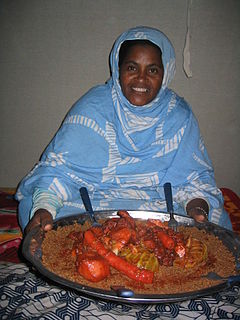
The cuisine of Mauritania includes the culinary practices of Mauritania. Historically, what is now Mauritania has been influenced by Arab and African peoples who have lived in and traversed the "stark" landscape marked with Sahara desert dunes in caravans. There is an overlap with Moroccan cuisine in the north and Senegalese cuisine in the south. French colonial influence has also played a role in influencing the cuisine of the relatively isolated land. Alcohol is prohibited in the Muslim faith and its sale is largely limited to hotels. Mint tea is widely consumed and poured from height to create foam. Traditionally, meals are eaten communally.
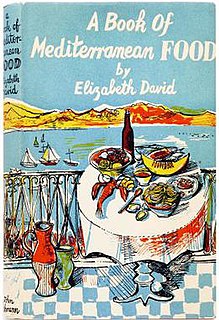
A Book of Mediterranean Food was an influential cookery book written by Elizabeth David in 1950, her first, and published by John Lehmann. After years of rationing and wartime austerity, the book brought light and colour back to English cooking, with simple fresh ingredients, from David's experience of Mediterranean cooking while living in France, Italy and Greece. The book was illustrated by John Minton, and the chapters were introduced with quotations from famous writers.
| This article about kitchenware or a tool used in preparation or serving of food is a stub. You can help Wikipedia by expanding it. |